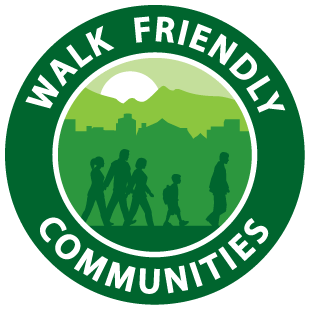Community Highlights
Bellevue is designated as a Silver-level community due to its excellent engineering practices, planning programs, and high mode share for transit and walking. Highlights of Bellevue’s application include:
- The Pedestrian and Bicycle Transportation Plan, which has guided pedestrian and bicycle system investments in Bellevue for over two decades. In 2015, City Council launched the Pedestrian and Bicycle Implementation Initiative to put energy behind “action-oriented efforts that will advance project designs and programs.”
- An Annual Progress Report website provides detailed metrics showcasing the City’s investment in pedestrian facilities. The portal also provides the latest pedestrian and bicycle count data collected by the City.
- In 2018, the Bellevue Transportation Commission approved the Multimodal Level of Service (MMLOS) Metrics, Standards and Guidelines report, introducing performance metrics, standards, and guidelines for every travel mode.
- Bellevue’s unique approach to the Open Streets concept is the Neighbor Link Block Party Program. The City has supported more than 300 street closures since 2009 as part of the program, which is centered on connecting neighbors through service and celebration.
- Consistent with its Vision Zero policies, the City of Bellevue is committed to generating better data on travel behavior, patterns, crashes, and conflicts and developing collaborations with others in the public and private sector to make our intersections smarter and safer. The Video Analytics Toward Vision Zero Project was originally developed through a partnership between the City of Bellevue and Microsoft to convert raw video footage from the City of Bellevue’s camera network into useful data that can be searched, managed, and used to provide detailed information on traffic flow and allow a more rapid response to non-crash traffic conflicts. The City and its partners are working to process video footage from 80 Bellevue traffic cameras, develop a road safety dashboard, conduct a safety diagnosis at high-risk locations, and identifying recommendations for those locations.
- The Practices and Priority Guidance for Allocation of Crosswalk Related Resources, which is used to develop annual and five-year project lists. The city has six categories of crossing treatments that help city engineers verify that the marked crosswalk site meets applicable standards and principles, while also allowing staff to contemplate additional enhancements.
- The walking mode share in Bellevue is four percent; however, considering the city’s 11% mode share for transit, there are certainly many more people who include walking as part of their commute trips. Good service hours and headways make transit an attractive option for residents and the city is continually evaluating its service with Trends in Transit reports, part of the Bellevue Transit Master Plan.
- Elementary schools in Bellevue have 20 mph school zones, and most schools have flashing beacons to accompany the reduced speed limit signs. The city has seen significant reduction in speed after installing photo-enforcement systems around two elementary schools that are located along arterial roads.

